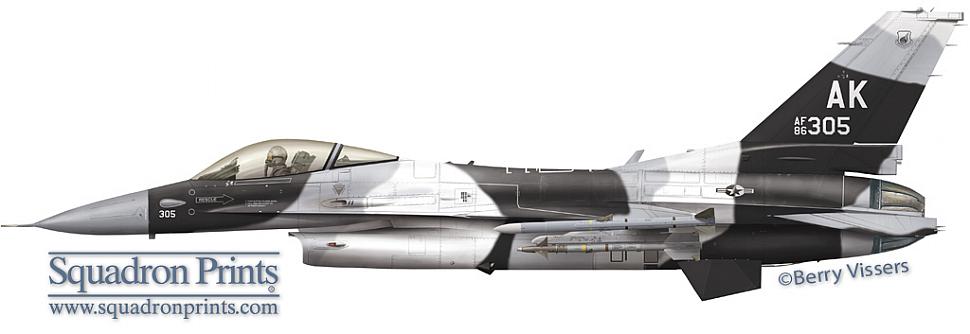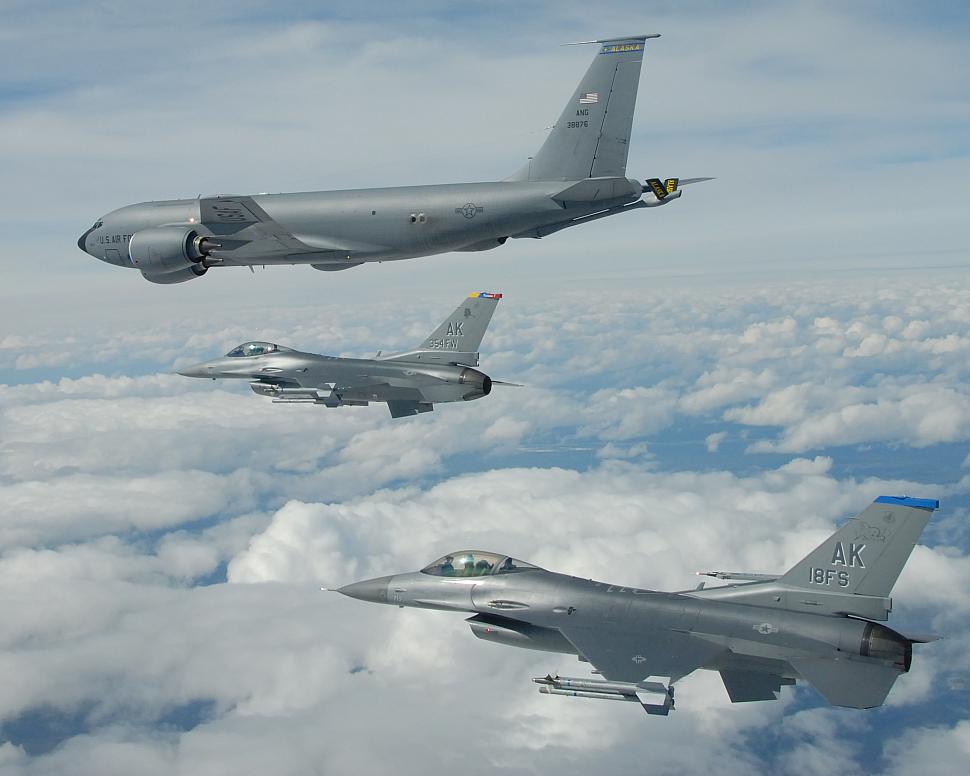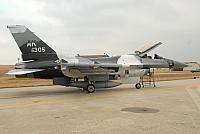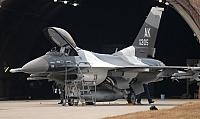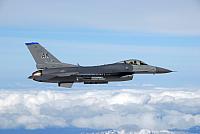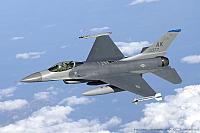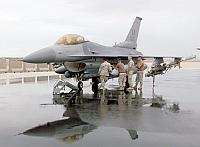 |
18th Aggressor Squadron ( USAF PACAF)" Blue Foxes" |
 |
18 AGRS " Blue Foxes" ( USAF PACAF) | |||
| Status: |
Active
|
|||
| Version: | F-16C/D block 30 | |||
| Role: | Aggressor | |||
| Tailband: | N/A | |||
| Motto: | Have At You | |||
| Badge: | N/A | |||
F-16 History
On March 7th, 1991 the 18th TFS began giving up it's A-10s when the squadron received its first F-16C of the block 40 version. Shortly after the first F-16 was received and still during conversion, the squadron was re-designated the 18th Fighter Squadron dropping the word Tactical. Once conversion was complete the squadron was the only active duty F-16 Close-Air-Support squadron as its primary mission. They did this in conjunction with the 355th FS which also resides at Eielson AFB as an A-10 unit. In what became a big year for the 18th FS, 1991 also saw the move of Cope Thunder to Eielson. In previous years the exercise was held at Clark AFB, Philippines. With the massive eruption of Mount Pinatubo, Clark AFB was forced to close and the Cope Thunder exercise, which had been held there since 1976, had to move as well.
Tragedy struck on February 19th, 1993 when Captain Glen S. Porter and flight surgeon Major Dr. Robert Verdone were killed in their F-16D twenty miles east of Eielson. Three months later, Captain Luis Jordan was killed in an F-16 crash 60 miles east of Eielson AFB.
On August 20th, 1993 the parent wing was re-numbered from the 343rd Wing to the 354th Fighter Wing without changing anything in the structure or mission of the squadron.
Taking advantage of an opportunity for dissimilar combat training the 18th Fighter Squadron deployed in 1997 to Singapore for Commando Sling and then to Malaysia for Cope Taufan. The Cope Taufan was a particularly unique as it allowed the Vipers of the 18th FS to fly against the MiG-29.
2003 was a busy year as it saw the unit go to Anderson AFB in Guam in support of Operation Noble Eagle during March and the squadron also participated in Commando Sling during October.
During the 2005 BRAC proceedings, it was announced that the 18th FS would be disbanded. However, one of the early changes to a BRAC decision came as the realization of how succesful Red Flag - Alaska actually was. Previously the exercise held in Alaska was Cope Thunder, but will be rebranded as 'Red Flag - Alaska'. Instead of in the past, deploying a detachment of 64th FS (and before this the 414th CTS), the 18th FS would instead convert to an Aggressor Squadron. The block 40s would be sent to Kunsan AB for the 80th FS making the 8th FW an all block 40 wing. The 80th FS block 30s would be sent to the 18th AGRS. Officially the squadron stood down on June 23rd, 2007 to become the 18th Aggressor Squadron on August 24th, 2007. Aircraft were painted in Kunsan but didn't arrive at Eielson AFB till very early 2008. But before the block 30s arrive all the block 40s were sent to the 80th FS the week of January 14th to 18th 2008. Out of the 18th Aggressor Squadron came a unique artic aggressor scheme which uses black, white and grey. About three or four aircraft wear this scheme while the rest wear the standard aggressor schemes.
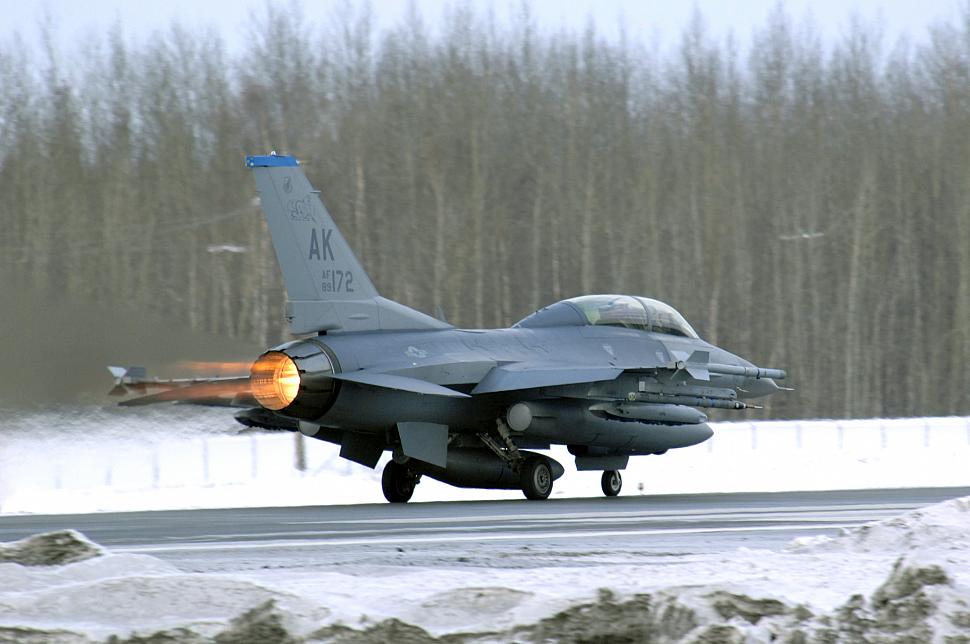
Aircraft Markings History
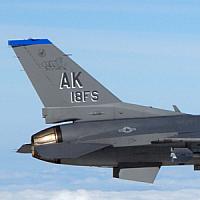
A simple blue band was used, fitting for the 'Blue Foxes'. Tail code of AK (short for Alaska) was applied. All these tail markings were carried over from the A-10 days with an outline of the squadrons mascot added to the markings in later years.
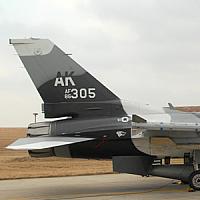
A standard agressor scheme adorn the 18th Aggressor Squadron's aircraft. The tail band was removed but the 'Blue Foxes' kept their AK tailcodes. A number of aircraft are painted in a grey, black and white aggressor color scheme.
Unit History
- 1940: Activation of the squadron in Moffet Field, Calfornia
- 1940: P-36 'Hawk'
- 1940: P-36 'Hawk' (Hamilton Field, California)
- 1941: P-36 'Hawk' (Elmendorf Field, Alaska)
- 1941: P-40 'Warhawk'
- 1942: P-40 'Warhawk' (Greely, Alaska)
- 1943: P-39 'Airacobra' (multiple bases in the Pacific Theatre)
- 1943: P-38 'Lightning' (multiple bases in the Pacific Theatre)
- 1946: P-51 'Mustang' (Ladd Field, Alaska)
- 1946: Disbanded
- 1952: Activation of the squadron in Minneapolis–St Paul, Minnesota
- 1952: F-51 'Mustang'
- 1953: F-86 'Sabre'
- 1954: F-89 'Scorpion' (Ladd AFB, Alaska)
- 1957: F-102 'Delta Dagger' (Wurtsmith AFB, Michigan)
- 1960: F-101 'Voodoo' (Grand Forks AFB, North Dakota)
- 1971: Disbanded
- 1977: Activation of the squadron in Elmendorf, Alaska
- 1977: F-4E 'Phantom II'
- 1982: A-10A 'Thunderbolt II' (part of 343 FW, Eielson AFB, Alaska)
- 1991: F-16C/D 'Fighting Falcon'
- 1993: F-16C/D 'Fighting Falcon' (part of 354 FW)
Deployments
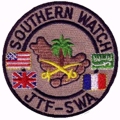 |
' Southern Watch' |
| Ahmed Al Jaber AB, Kuwait (October of 1998 to December of 1998) | |
| Operation Southern Watch was an operation which was responsible for enforcing the United Nations mandated no-fly zone below the 32nd parallel in Iraq. This mission was initiated mainly to cover for attacks of Iraqi forces on the Iraqi Shi’ite Muslims. | |
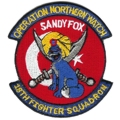 |
' Northern Watch' |
| Incirlik AB, Turkey (September of 2000 to December of 2000) | |
| Operation Northern Watch was a US and European Command Combined Task Force (CTF) which was responsible for enforcing the United Nations mandated no-fly zone above the 36th parallel in Iraq. This mission was a successor to Operation Provide Comfort which also entailed support for the Iraqi Kurds. Around 110 crew deployed with five F-16s. During this deployment the squadron performed the first ever F-16 Combat Search and Rescue during ONW. | |
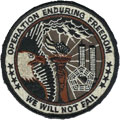 |
' Enduring Freedom' |
| Ahmed Al Jaber AB, Kuwait (December of 2001 to March 22nd, 2002) | |
| The Blue Foxes were scheduled to deploy for Operation Southern Watch (AEF 9/10 Cycle 2) but mostly ended up flying missions for Enduring Freedom. The squadron should have returned in February but due to the war in Afghanistan they stayed through till March. Flying more than 3,200 hours with 142 support personnel and ten aircraft for a grand total of 790 sorties. During that time, the 18 FS flew missions in support of Operation Anaconda, including one in the Shah-I-Kot valley on March 2nd (some sources say March 4th) when US forces, engaged in a firefight with Taliban and Al Qaeda forces, called for aerial assistance. A number of Blue Foxes responded, dropping bombs with pinpoint accuracy on the opposing forces. Two pilots of the 18th FS received Distinguished Flying Crosses for their work performed over Afghanistan. |
F-16 Airframe Inventory
- All 18 AGRS F-16s in our F-16 Aircraft Database (past and current aircraft)
- Current 18 AGRS F-16s in our F-16 Aircraft Database
Photos
Please use this form to add any list any error or omissions you find in the above text.
Note: your comments will be displayed immediately on this page. If you wish to send a private comment to the webmasters, please use the Contact Us link.

